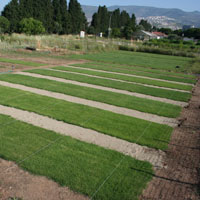Effects of overseeding times on different warm-season turfgrasses: Visual turf quality and some related characteristics

Accepted: 18 July 2021
PDF: 429
All claims expressed in this article are solely those of the authors and do not necessarily represent those of their affiliated organizations, or those of the publisher, the editors and the reviewers. Any product that may be evaluated in this article or claim that may be made by its manufacturer is not guaranteed or endorsed by the publisher.
The sustainability of warm-season turfgrass species in winter dormancy is a major concern in Mediterranean ecology. The concept of overseed a lawn has been still new for many developing countries such as Turkey as part of a regular maintenance. Therefore, a 2-year study was conducted at the experimental fields of Ege University, Izmir/Turkey during 2014-2016 years to compare the effects of four different overseeding times (September 15, September 30, October 15 and October 30) on four warm season turfgrass species (Cynodon dactylon cv. SR9554, Cynodon dactylon × Cynodon transvaalensis cv. Tifway-419, Paspalum vaginatum cv. Sea Spray and Zoysia japonica cv. Zenith) by measuring visual turf quality (1-9 score) and some related characteristics as texture (mm), cover (1-9 score), weed infestation (1-9 score) and colour (1-9 score). ‘50% cv. Troya+50% cv. Esquire’ perennial ryegrass (Lolium perenne L.) mixture was used for overseeding in trial. According to results, visual turf quality performance of 6.0 scores and above were obtained from all treatments. We concluded that October 15 should be most suitable time for overseeding applications. Additionally, L. perenne L. can be practiced successfully in Mediterranean region in order to eliminate the concerns of warm-season turfgrasses in the winter dormancy period observed in cold temperatures.
Highlights
- No gaps were formed in plots and high coverage degrees were maintained during overseeding periods in all treatments.
- Homogeneous spring transition was occurred from Lolium perenne L. to warm-season turfgrass species in all overseeding times.
- Visual turf quality performance of 6.0 scores and above which is acceptable level were obtained from all overseeding times.
- Better results were obtained from overseeding applications on Paspalum vaginatum and Cynodon dactylon × Cynodon transvaalensis.
- The different results among the warm-season turfgrass species can provide effective information for future research studies.
How to Cite

This work is licensed under a Creative Commons Attribution-NonCommercial 4.0 International License.
PAGEPress has chosen to apply the Creative Commons Attribution NonCommercial 4.0 International License (CC BY-NC 4.0) to all manuscripts to be published.

 https://doi.org/10.4081/ija.2021.1820
https://doi.org/10.4081/ija.2021.1820



